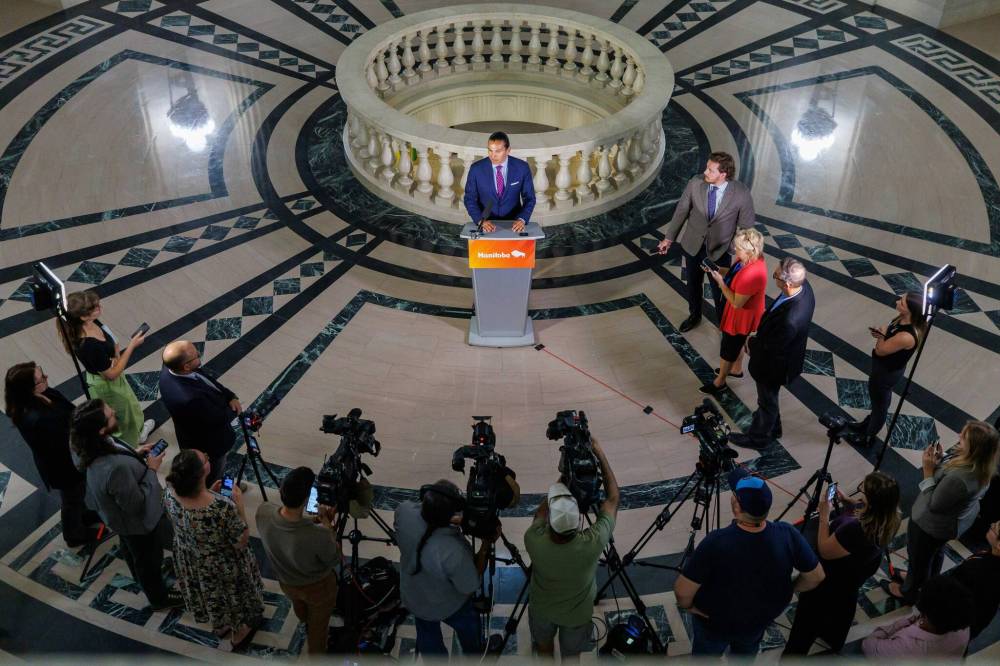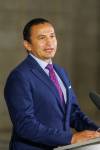Rating the Kinew government at the halfway point
Advertisement
Read this article for free:
or
Already have an account? Log in here »
To continue reading, please subscribe:
Monthly Digital Subscription
$1 per week for 24 weeks*
- Enjoy unlimited reading on winnipegfreepress.com
- Read the E-Edition, our digital replica newspaper
- Access News Break, our award-winning app
- Play interactive puzzles
*Billed as $4.00 plus GST every four weeks. After 24 weeks, price increases to the regular rate of $19.00 plus GST every four weeks. Offer available to new and qualified returning subscribers only. Cancel any time.
Monthly Digital Subscription
$4.75/week*
- Enjoy unlimited reading on winnipegfreepress.com
- Read the E-Edition, our digital replica newspaper
- Access News Break, our award-winning app
- Play interactive puzzles
*Billed as $19 plus GST every four weeks. Cancel any time.
To continue reading, please subscribe:
Add Winnipeg Free Press access to your Brandon Sun subscription for only
$1 for the first 4 weeks*
*$1 will be added to your next bill. After your 4 weeks access is complete your rate will increase by $0.00 a X percent off the regular rate.
Read unlimited articles for free today:
or
Already have an account? Log in here »
Rating the performance of leaders and the governments they lead is a popular activity among media commentators and academic scholars in disciplines like history and political science.
Such assessments typically focus on two broad sets of factors: the difficulty of the problems being addressed during a particular time period, and the leadership attributes and decisions of the first minister and other elected members of the governing party.
Government actions seldom result in outright successes or absolute failures; instead the outcomes are usually mixed. This reality tends to get lost in the adversarial clashes between competing political parties, with the opposition exaggerating the shortcomings of government while the governing party boasts of its accomplishments and the constraints it faces in dealing with major problems. Such exchanges and the related media coverage shape what topics are top of mind for voters and how they assess the performance of governments.

MIKE DEAL / FREE PRESS
Premier Wab Kinew speaks to the media after question period during the first day of the second session of the 43rd legislature.
Most of us, most of the time, are casual spectators to the policy process who cheer or boo based on selective attention to events. None of us can claim comprehensive knowledge of what has been attempted and accomplished by a particular government across multiple fields of public policy. Communications and the management of expectations have become central to the governing process.
With these general comments as preamble, I want to offer an interim and far from comprehensive assessment of the performance of the NDP government led by Premier Wab Kinew as it embarks on the second half of its four-year term which will end on or before the next election on Oct. 5, 2027.
Since taking office, the Kinew government has faced difficult and turbulent circumstances, such as the continuing negative impacts of the pandemic and the related economic downturn, post-pandemic inflation and the affordability crisis, the need to reinvest in public infrastructure after the austerity of the previous government, the Trump sponsored tariff war, the historic wildfires which forced mass evacuations, the morally compelling issues of reconciliation and the interrelated problems of poverty, homelessness and crime.
The NDP offered voters an ambitious campaign platform, with a strong focus on healthcare reform and affordability issues. In government it has been responsive to many outside demands. It has been prepared to make initially unpopular decisions, such as the landfill search, the welcoming of Gaza refugees and major changes to labour laws. It risked alienating elements of its base by retaining tax cuts made by the previous government, placing an emphasis on economic growth to support social spending and cutting the gas tax.
Public attention has focused on the continuing challenges of such high profile issues as accessibility to healthcare, homelessness, drugs and crime. Policy changes, supported by new capital and operational spending, have undoubtedly mitigated, not solved, serious problems. For example, investments in health care and a universal school nutrition program will definitely have long term benefits.
The government has called for patience as it seeks to address the damage and unsolved problems created by the actions and inactions of the former PC government. In a sped-up and disillusioned era, patience is in short supply and shifting blame to an opponent only works for a limited time.
Despite deficit and debt numbers headed in the wrong direction, the government continues to insist that the promise of a balanced budget by 2027 is achievable. In its recently released broad economic strategy document setting forth longer range development goals, it sets the target of becoming by 2040 a “ have” province which no longer relies on federal equalization transfers. Balancing realism and credibility with aspirations and hope is a requirement of successful governing at a time of pessimism and perceived scarcity of public money.
At mid-term the NDP is still riding high in the polls. In an era of personalized politics in which nearly all the media attention is focused on party leaders, the government has benefited greatly from the leadership skills and image of Premier Kinew, who for two years has been the most popular first minister in the country. A demoralized, weak PC party, led until recently by an interim leader, has no doubt contributed to approval for the premier and his party.
The premier is the single most important actor in provincial government, whose leadership philosophy and operational style plays a crucial role in the achievement of success. A popular analytical tool used to compare leaders involves a set of dichotomies. Along a continuum, I would rate Kinew as more practical than ideological, more active than passive, strong rather than weak in his leadership style and more innovative than status quo in his policy approaches.
Kinew has exhibited contextual intelligence, by which I mean reading situations and issues shrewdly. He can be combative in clashes with the opposition and when sparring with the media, but his sense of occasion and strong communications skills have defused wider potential conflicts and enabled the party to build a broad coalition of supporters.
Nearly all Manitoba governments last more than one term and this will likely be the case with the current NDP. After eight or more years of governing and with the benefit of hindsight, there would be more evidence on which to rank the accomplishments of Premier Kinew and his governments.
No one should be surprised if the record is mixed.
Paul G. Thomas is Professor Emeritus of Political Studies at the University of Manitoba.


